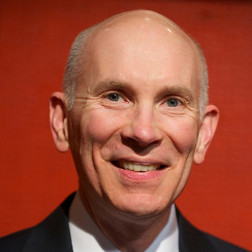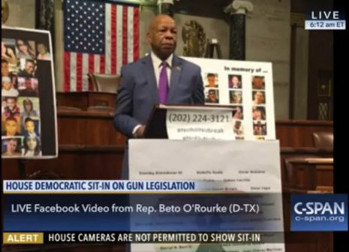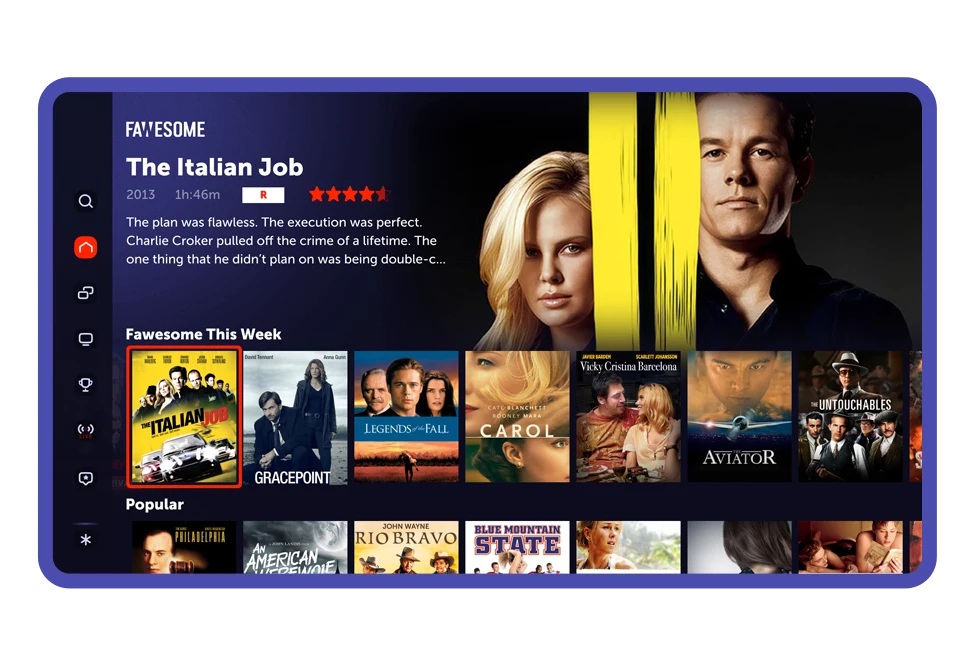GV Expo: A Q&A With C-SPAN Co-CEO Robert Kennedy
WASHINGTON—Robert Kennedy, president and co-CEO for the C-SPAN network, will address the Government Video Expo at 1 p.m. on Wednesday, Dec. 7. In his presentation, “The C-SPAN Perspective: Opportunities and Challenges in the Digital Era,” Kennedy, who first spoke at Government Video Expo in 2000, will provide an update on how the network—a non-profit organization primarily financed by the cable industry—has responded to challenges posed by the digital environment and how the network's use of technology has evolved and expanded over the years.
Government Video Editor Tom Butts recently spoke with Kennedy about his upcoming GV Expo address and C-SPAN’s role in providing citizens with access to federal, state and local government and political events.
Government Video: What is your role at C-SPAN?

Robert Kennedy: At C-SPAN, we have co-CEOs, myself and Susan Swain. Susan and I have been in this leadership role together since the late 1980s. We have shared day-to-day operating responsibility for operations at C-SPAN and we've always worked together as a team, but we also each have areas of emphasis. We don't make all decisions together; but we do make the big decisions together. Within our areas of emphasis, we take more of a “hands-on” role: Susan focuses on our content, marketing, communications, and messaging. We joke that Susan is the software side of the company and I'm the hardware side. My areas of emphasis are technology, finance, affiliate relations, and the digital side of the company. Then we work on all strategic issues together.
GV: What are the most significant changes that have occurred at the network since you last spoke GV Expo in 2000?
RK: In 2000, I think we had identified a lot of the trends that were going to shape our business and any network, video network business for that matter. Things like broadband, the internet being a way to distribute video content, the importance of respecting your customers' and your viewers' time, because there was so much choice out there, and the way the internet can be used to distribute video. What I don't think we saw was just how much of a change was going to be affected by the internet and broadband. One thing, in particular—nowhere was it in my notes—did we really respect the degree to which mobile would become such an important part of our lives. I look at my notes from 2000 and we talk about putting video online and making it searchable. We did all that. We've got a good story to tell in that regard, but I think the degree of change brought on by the internet was just not something we could see in 2000.
GV: How important is election coverage to C-SPAN's overall programming?
RK: We start back with our mission, which is basically to bring official Washington and politics to everyone in their living rooms. We start with the coverage of Congress, whenever the House or the Senate is in session. Campaigns are certainly part of that. In the early part of any presidential campaign, we cover a lot of what we call “retail politics” events. These will literally be candidates on street corners, factory gates, or in diners as they test the waters in Iowa, New Hampshire, and other states. It's up close and personal coverage. As the primary season goes on, there are a lot of debates, some of which are sponsored by other networks. Then it leads up to the conventions.
The conventions are also very important for us because we show them, as we always have, from beginning to end, with every speech from the podium being delivered to our audience. Once the conventions are over, we get a lot stump speeches by the presidential candidates. We get the debates, which other networks cover as well. During the fall campaign season, we also work with local television affiliates and other organizations across the country to bring debates in from key governor, Senate, and House races. Once the presidential campaign hits the mainstream in the fall, we're able to broaden our coverage beyond just the presidential campaign and include these other key races. It's a very important part of what we do. We realize there are some parts of the campaign where we're doing things that are very unique, and that there are other parts later in the campaign where the coverage is everywhere. We try to be different by adding in these other races.
GV: There was a lot of talk during this campaign season that the media was slanted one way or another, and that it's gotten more intense over the years. Would it be safe to say that that doesn't really affect how C-SPAN has operated over the years? And regardless of how the other media operates, that that's not going to have an effect on how C-SPAN operates?
RK: It's a good question. It's hard for me to speak for the other media, but cable news, broadcast news and all of the internet news outlets have a duty and a motivation to build their viewership and build their brand. They try different things throughout the campaigns and throughout the news cycle to build on their competitive position. We're fortunate in that, as an event-based network, our goal is simply to go in the room [I'm simplifying this], get a camera in the room, or in some cases several cameras, and just let the audience see what's going on in the room. We don't talk over it. We don't edit it. We don't explain it. It's really an effort to make the viewer feel as though they were there. The one place where we do bring in some reaction, interestingly enough, is from our audience through our call-in programs, which has been something that we've done since 1980. It's a very important part of what we do, which is to give our audience a voice.
It’s a daily three-hour program we call “The Washington Journal,” and it's on at 7:00 a.m. ET every morning. On any given day, we'll try to take 60 viewer calls, which averages to 20,000 over the course of the year. It's a great way to hear the American public and what they're thinking and how they're reacting to the candidates. The calls are from all over the country. I like to think of it as a way to really bust out of our bubbles, because we tend to have bubbles that we're in based on where we live, what we watch, or who we listen to. Our callers give us a great perspective on how things look from their vantage point.
GV: How has C-SPAN's relationship with Congress evolved over the years? Has it always been friendly, or have there been issues depending upon who's in power?

A screenshot of C-SPAN's broadcast of a Facebook Live stream during the near 26-hour sit-in in the House of Representatives.
RK: I think it has always been generally beneficial. As you know, the House agreed to go on television first in 1979, then the Senate in 1986. In our productions, we've always tried to show respect for the institutions, the buildings. We work closely with the radio and television galleries on the hill to make sure that our productions are as unobtrusive as possible. Because of our gavel-to-gavel approach— beginning to end, not only of the bodies or chambers, but any congressional committee—I think it has worked to our benefit. Different parties are in the majority and the minority, that switches, but we're always giving both sides equal say because of our gavel-to-gavel approach. I think, generally, it has been good.
GV: How is social media affecting C-SPAN's coverage?
RK: There are so many ways. I think there's a couple things. In general, social media is a great two-way conduit with our audience, that allows us to share information about what's going on on the network.
GV: So you have a very active Facebook presence with your audience?
RK: We do, both Facebook and Twitter. One way is to let people know what is going on. Twitter, Facebook, and YouTube are also complimentary ways to distribute our content. We've done some Facebook Live and posted quite a bit on YouTube. There's a great audience within the various social media platforms, to the extent we can put some of our content in front of that audience and say, "This is a sample of what you get on C-SPAN. This is the type of thing that C-SPAN puts on and the way we cover the campaign." It's a great way to inform and attract a new audience. It's also just a great way to listen to your audience. It might be a technical or editorial issue, or it could even be a tweet about the music we play during quorum calls. It's an around-the-clock focus group, and we look at it and regularly review what we're hearing. It's a two-way conversation with our customers, and also a distribution platform.
GV: The sit-in, this past summer with Congress, how did that impact C-SPAN and how you possibly plan for future such events?
RK: The sit-in was really a watershed moment for a couple of reasons. As we know, the basic story, the cameras in the House are controlled by the House representatives, and always by the majority. On that particular day, the Republicans shut off the cameras. The Democrats chose to keep going on the House floor. Once the cameras were off, the Democrats chose to stream the event using Periscope and Facebook Live. Our producers were able to find those feeds. We have a producer on Capitol Hill and then we have producers here in the control room, who were able to find those feeds, turn them around, and put them on air.
Our viewpoint was that it was something going on on the House floor. It was something that was being transmitted. Yes, it's being done by one party, but we've covered many different events over the year put on by one party or the other, whether it's their convention, retreat, or other sort of party caucuses. Because of the unusual nature of the sit-in, it was the first time anything like that had happened. It brought us a lot of attention, and became one of our largest events, in terms of viewership and audience reaction, of the year. It increased the visibility of C-SPAN and what we do. I think it was very nimble work by our producers. We're always looking for new ways to bring official—and maybe you could argue this is “unofficial”—Washington into viewers' living rooms and politics and public affairs. It was a breakthrough for us.
GV: Was there any trepidation in the fact that you were giving over control of the coverage to someone who was not associated with C-SPAN?

RK: Not really at that point. We thought this was a public gathering that people could see in the galleries. From a production standpoint, it did have its fits and starts, for lack of a better word. One feed was lost and the other one was picked up. We were still hearing voices of members of Congress, we do that in many other venues throughout. We didn't have an editorial concern about it. It was, perhaps, different technically than what we'd done in the past, but we thought that the public interest was such that to have some technical hiccups was acceptable.
GV: Do you have a system in place now that might make it easier if that occasion arises again?
RK: This is kind of a technical answer, but we have good systems for getting the web to television. The trick on that particular day was finding the various feeds. We were quickly able to get enough people assigned so that we could find them, but one would drop and then another one would come up. I think we're ready for that, generally. I think that it was just a case where some of these live transmissions don't have consistent quality.
GV: Are there any new technologies C-SPAN is looking to enhance its coverage, such as drones, for example?
RK: We're doing some preliminary research into drones. We're learning about the requirements. We're looking at the technology, trying to think about how we might fit that into some of our productions as maybe a means to get a reference shot. It's definitely one thing on our list.
GV: Are you happy with the number of cable systems that are carrying C-SPAN and are you looking at OTT, over the top?
RK: We’re very happy with the number of cable systems that carry C-SPAN. We're essentially in 100 percent of multichannel homes, with cable, satellite, and telco. The numbers there are very good, and they've held up really well compared to other programmers and the industry. What we've done with respect to OTT—at our website C-SPAN.org—we have a video library that contains every piece of video that we have shot since 1987. It's all free, easily searchable, and it can be streamed, you can make clips, and you can share the clips on your favorite social media channel. By the time we launched the video library in 2010—which I sort of talked about during my presentation at GV Expo in 2000—it was much bigger than anything we could have envisioned in 2000. All of that video in the video library is available to be streamed on any device. It works on mobile; it works on desktop. That really is a core of the public service we provide now. So, we have the three linear networks and the video library.
GV: Do you have an app?
RK: We have a radio app where you can listen to the audio of all three C-SPAN television networks and our radio station here in Washington. We have not done a video app. We made our website mobile-friendly, and felt that focusing on the website and the video library was where we should be right now because of our goal to provide public service through access to this content. We have the audio app, which is a live steaming app, we have the website, which is video on-demand and also mobile-friendly. That's where we are right now. We've talked a little about what an app should look like, and whether or not there is a value added, something we can do in an app, that we're not doing right now, either well on the video side or the audio side.
GV: Do you think that C-SPAN has influenced how television covers civic and community events? If so, how?
RK: I think we've shown that a medium shot with basic graphics and a respect for the viewer—without a bunch of bells and whistles that tries to draw them in and try and draw their attention—we've shown that solid production values still matter. We've seen that in coverage, whether it's a state C-SPAN, state public affairs networks modeled on C-SPAN, trying to get started or local communities. I think we've shown that there's an interest in watching civic or community events. We've tried to stay true to our mission and employ production values that don't distract from the activity. I think we're seeing other people who are doing that as well.
To register for Government Video/National Drone Show, Dec. 6-8 at the Walter E. Washington Convention Center in Washington, D.C., visitwww.gvexpo.com.
Get the TV Tech Newsletter
The professional video industry's #1 source for news, trends and product and tech information. Sign up below.
Tom has covered the broadcast technology market for the past 25 years, including three years handling member communications for the National Association of Broadcasters followed by a year as editor of Video Technology News and DTV Business executive newsletters for Phillips Publishing. In 1999 he launched digitalbroadcasting.com for internet B2B portal Verticalnet. He is also a charter member of the CTA's Academy of Digital TV Pioneers. Since 2001, he has been editor-in-chief of TV Tech (www.tvtech.com), the leading source of news and information on broadcast and related media technology and is a frequent contributor and moderator to the brand’s Tech Leadership events.

